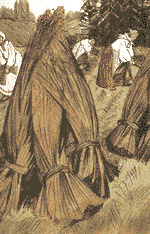This culture was cultivated
still in ageian the period. Further flax has received a wide circulation
in Greece and Rome where from the fabrics produced from a linen yarn, produced
clothes (for example, chitons), subjects of military equipment (for example,
a lining for an armour), bedding, a canvas, a rigging. Besides the linen
canvas was used as a material for writing pictures (doleful portraits).
Flax was cultivated mainly in Egypt, the Top Italy, Gallia and Spain. In
process of expansion of scales of sea trade in Renaissance, need(requirement)
for it(him) has considerably increased. Products from flax were exported
even to India. From reached us it is exemplary prevail " ckptian's fabrics
" from Egypt, however they cannot be named a high-quality product from
flax.
In. D. Smooth " the Ancient World " Volume 1.
In pyramids of five-thousandth
prescription mummies wrapped up in linen cloths (now they are stored(kept)
in Metropolitan Museum in New York) were found.

Delivered to Northern Europe
Romanians, linen clothes become a symbol of Middle Ages.
In 1812 was
invented and for the first time the weaving loom is applied.
Flax
in Russia
In Russia
flax is known from the second millenium B.C.. Ancient writings speack about
manufacturing by slavs of linen fabrics (IX-X Up to AD). East authors
of that time describe slavs dressed in linen clothes. From flax the canvas,
fishing networks, ropes, and also linen oil was made. The border of cultivation
of this culture in X-XII centuries has reached to areas of Pskov, Novgorod
etc.
Development of the linen industry
in XVIII century.
The basic mode of production in
Russia XVIII centuries were manufactories. At this time in the textile
industry 32 private(individual) manufactories and 6 state, from which worked:
13 cloth;
15 linen;
10 silk.

In Russia it was necessary to liquidate economic backwardness to provide
army with regimentals and sails for the ships.
In 30-40-х years
of XVIII century the wages of weavers made 18-24 roubles per one year.
Thus on livelihood of one person it was necessary 7 roubles per one year
(1 kg brode=0,8 copecks). In 1725 at 15 enterprises it is borrowed(occupied)
3000 workers, in 1799 - 29000 workers. For this time export of production
of weavers has increased with 1856 тыс.pud's up to 4450 тыс.пудов, that
made 19,1 % from total amounts of export of Russia.
In "piter's"
times linen the enterprises were concentrated around of Moscow. From 15
manufactories in 1725 9 were placed in Moscow and district. Then the industry
was distributed in the next provinces. At the end of XVIII century up to
40 % of all parusno-linen fabrics gave the Kostroma area.
The
Linen industry in XIX century.
In XIX century
Russia becomes the main supplier of flax on the European market. In middle
of XIX century in Europe it was made 347 thousand tons of flax, from them
Russia made 196 тыс.т, Austria - 47 тыс.т.
From all fibre
submitted in the world market - 64 % of the Russian manufacture. However,
on manufacture of fabrics, Russia was on one of last places - 0,45 arshins
on soul. At the same time in England this figure was 18-15, in France -
9-11. The need(requirement) for a fabric was satisfied with domestic country
manufacture. In view of it on soul it was necessary 3,7 arshins of a fabric,
that basically not удовлятворяло to need(requirement). On village it was
necessary 10 arshin, on city of 20 arshin on soul.
In I-ой half
XIX centuries manufacture of fabrics from flax and hemp changes, the quantity(amount)
of the enterprises is reduced with 320 in 1800 up to 117 in 1860. The enterprises
are integrated. The volume of production in 1860 has made 30 million 500
thousand arshin.
Since 1861, after liquidation of
the serfdom, manufacture of flax and hemp develops accelerated. The crop
of flax has grown about 11 million poods in 60th years up to 30 million
in 1913. Crops of hemp have grown with 6 up to 22 million poods. Crops
of flax were distributed to the east. In end I-ой of world War on 1 place
on manufacture of flax the Vjatskaja province, for not Pskov and Smolensk
leaves. Export of flax grows, almost 70 % of a crop was taken out in foreign
countries.
Development
of the linen industry in XX century.
In the beginning
of XX century the linen industry let out production on 40 % from
total amount of manufacture of Russia. Russia practically has caught up
the advanced capitalist countries.
In 1913 200 enterprises on which
85000 workers were borrowed(occupied) worked. Areas under crops under flax
made 1250 тыс.га. A crop - 443 thousand tons. By 1932 areas under crops
have increased up to 2510 тыс.га, however productivity has grown a little
bit - 498 тыс.га. Distribution of crops to new areas - Siberia, Ural reduced
quality of a fibre, урожнайность these crops was not big. The share of
a short fibre - 76 % at this time grows.
Transition to industrial initial
processing a fibre begins. In 1924 the first was open in Russia linen-factory
in city of Rzhevs. In 1931 worked already 38 linen-factory, by the end
1932 - 394. The share of a fibre of factory processing made 42 %.
With 1936 productivity
has decreased to 1950 with 2,7 ц/га up to 1,3 ц/га. Areas under crops at
this time practically did not change, they made about(near) 2150 тыс.га.
Stability of the areas of crop was kept till 1980, thus productivity for
these years changed within the limits of 1,7-4 ц/га. At the same time productivity
in such countries as Belgium, France, Holland was much higher till 15-18
ц/га.
Since 80th years
the linen industry of Russia has not best times. In branch there are many
problems: low productivity of crops, poor quality of a received fibre (is
no higher N14), weaver's and spinning mills feel sharp need(requirement)
for raw material which they are compelled import from foreign countries.
But it would be desirable to trust, that all these problems time and soon
flexworckers will return Russia the former glory of Russian flax all over
the world.
Flax in Belgium
During centuries
flax cultivated and received from him(it) fabrics in the most western area
of Belgium - Flanders (Flanders), known from Renaissance. The climate and
the relief of this district crossed with set речек - is ideal for cultivation
of flax.
In 1275 in city
of Tielt the first linen stock exchange was based. The stock exchange prospered
and supported weavers of this region. Since 1300 the river Mandel was used
for reception trusts (raw material for reception of a fibre - see. Reception
of a fibre). Further the linen craft was distributed for limits of Flanders
(Flanders). Most widely flax started to be cultivated from area of Foxes
(Lys) which further becomes one of the main manufacturers of linen clothes.
The industry has brought extraordinary riches and prosperity in this area.
At the end of
18 beginning of 19 centuries, the textile industry of the Belgian area
Flanders prospered. By 1796 in vicinities of small town Tielt, 17 % of
inhabitants were occupied in linen branch, to 1840 this figure has grown
up to 71 %.
In Belgium there
were also other "linen" areas. It is known, that when Романцы have won
the Belgian small town the Gaul, they were struck with beauty of linen
fields and fine products which were made in this area. Traditions cultivate
flax developed centuries and by the end of 16-th century of steel the basic
indastry in this district, having introduced extraordinary prosperity in
life of such cities, as Brugge and Kortreyck.
However, in 1850,
development of the linen industry was slowed down a little. It was caused
by the following reasons. The cotton industry developed the big rates,
the trading barriers caused by increase of taxes to export grew. Thereof
volumes of export to Spain and its JUzhno-American colonies which were
rather important commodity markets have decreased. Also, in Англиии there
was induvstrial a revolution, and the Belgian handicraftsmen still applied
manual weaving looms and could not compete to the large mechanized factories.
The city of
Mjulebek (Meulebeke), from it(him) almost 65 % of a labour occupied in
the linen industry has sufferred the big impact. The French
and English competitors have quickly left behind of the Belgian handicraftsmen.
Urgently it was necessary to modernize means of work.
In 1846 in area the Rouler the
mechanical spinning machine tool for the first time was applied and Belgian
linen industry has followed the road mechanization. The first completely
mechanized weaver's factory was open in 1860 in Meulebeke. In 1858 firm
Lagae Linens was based, and in 6 years and firm Libeco which work and represent
Belgium and now.
Flax
in Ireland
In Ireland flax станвится is known
during acceptance of Christianity when in the chapter of the Irish Church
was St. Patrick.He has told, that wants be dead in cloths from the Irish
flax. Manufacture of linen fabrics and development of the textile industry
proceeded all средневоковье.
At the end of 17 centuries Huguenots which in the past
ran from France to Ireland, have introduced the valuable knowledge and
ideas in already and so not bad advanced textile industry of Ireland. The
Irish flax has found glory and popularity in all Europe. The industry was
concentrated mainly on nord of Ireland on territory between two great rivers
Bann and Lagan. This place is known and today as the Linen Homelands.
The linen industry was in the centre of industrial revolution in the north
Ireland.
In 20-th century flax has played the big role in two
World wars. Cords, networks, clothes of seamen, a canvas, awnings and wings
for airplanes were made of flax.
After the Second World war, synthetic fibres have replaced
flax in manufacture of these products of the heavy industry. However, despite
of growing interest in 60-70 years to fibres made by the person, such as
nylon and poleaster and to new fibres - to microfibres, linen fabrics and
products remain modern and today. The linen fibre mixs up with such new
synthetic fibres as тенсел (tencel) and lycra. The received fabric has
the best properties, keeps the color better and has a great demand in the
market.
Irish count flax the pride and aspire to not lose this
rich inheritance of handicraftsmen
Flax
on New Land (Northern America)
Occurrence of flax on North American
continent is dated 1617, when Louis Herbert, the first farmer in Canada,
has delivered flax to New France. In due course, manufacture of flax extended
and moved to the west across continent. In 1875 European поселенцы have
sowed untouched prairies the flax brought from the native land. Cultivation
of flax prospered in a pure(clean) environment of Northern America, and
his(its) manufacture on the new ground developed.
Two world wars have increased demand
for flax as a source of oil for many products. After the Second World war,
manufacture of flax in Northern America has essentially extended.
During 50 and 60th years, products
of flax were widely used all over the world. Based on linen oil (oil-based)
the coverings decorated both added with a tree, and strong linoleum became
popular materials of sexual coverings. At the same time, the products based
on linen seeds become popular at observance of a diet.
Within last decades, flax remains popular, and progressive
Canadian manufacturers of flax are advanced, carrying out all new requirements
of consumers. The share of Canada in world production of flax was increased,
and in 90th years Canada becomes the main exporter of flax all over the
world.
The Source: the FlaxSite (With the support of the Flax Council of
Canada)
|
